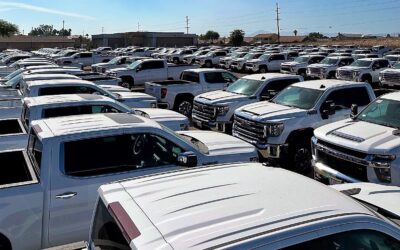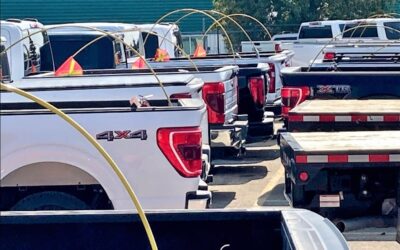Fleet Maintenance and Insurance: Is it more cost effective to Own or Rent Your Fleet?
One thing fleet managers are always trying to do is to reduce fleet costs. The reason is simple: sometimes the cost of a vehicle fleet is one of the biggest expenses any company encounters. Fleet management is a delicate balance, and there are several ways to control this expense. The question becomes is it more cost effective to own or rent your fleet?
The question does not have one simple answer. Instead, there are several factors to consider. Some will help you save money regardless of whether you rent or own your fleet, while others will help you determine the best way for your company to manage your vehicles.
Each company is different, and that means their fleet needs are equally different. Whether you own, rent, or find some hybrid method of fleet management, here are 10 factors to analyze.
Reduction of Fleet Size
It may sound obvious, but the fewer vehicles you own, the less your fleet costs will be. The average vehicle ownership costs for a light duty vehicle are $5,000 to $8,000 annually. The question is, do you need all of those vehicles? Are they being utilized to the fullest of their abilities?
This is where truck rentals can come in. Instead of owning vehicles, you can rent them as needed and return them when you are done with a job. Generally, this can create a huge savings for any company. This means that the net savings will not be the total cost of ownership (TOC) of the vehicle depending on how often and for how long rentals must be utilized.
For instance, if you eliminate 10 vehicles from a relatively small fleet, the savings potential is 10 times the ownership cost, so $50,000 to $80,000. However, if you need to rent vehicles at various times to replace these, the cost of that rental is subtracted from your total savings. Therefore $50,000 in savings minus $40,000 in rental costs still equals a $10,000 annual savings or essentially a 20% reduction in costs.
Companies that eliminate a percentage of their fleet usually also experience costs associated with using other vehicles more along with the cost of rentals and additional fuel costs. This means that savings are closer to 10-!5%. Still, this is one of the largest cost reductions fleet managers can achieve.
Reduction of Miles Traveled
One of the most important ways to reduce costs is to reduce miles traveled even in the case of rentals. While fleet managers often have little to do with day to day operations and employee travel, there are some simple things they can still do to interact with supervisors and make a difference in the amount of time and mileage being spent on the road.
In other words, while vehicle travel is still necessary, there are many other options using modern technology. Employees can use simple teleconferencing apps to solve problems, offer solutions, and even close sales.
Technology also allows employee travel to be tracked, audited and even controlled to a certain extent. GPS can suggest the best routes and report unnecessary departures the employee might engage in when they feel “no one is looking.” The good thing is that many of these features are already available using existing company equipment and can be implemented with little to no investment. If the employee carries a company phone or laptop containing GPS or similar technology then it doesn’t matter which vehicle they are using, or if they are in a rental or a company owned vehicle.
The restructuring of territories, discouraging personal use, and other costly employee behaviors can all help reduce the miles traveled by your fleet. With little cost or addition of equipment, this can result in moderate to large amounts of savings, depending on your current spend.
Get Better Mileage
For the miles that your fleet does travel, the more miles per gallon you can get out of your vehicles the better. There are a few general rules that go with this, and a few simple things you can do to reduce consumption. Although you cannot be with drivers every single day, you can encourage better driver behavior and give them the right equipment to reduce the amount you are spending on fuel. Here are some simple tips:
Reduce Vehicle Size and Weight
A salesman headed to a client meeting does not need to take the ¾ ton crew cab pickup. Instead, that individual can take a light vehicle like a car or a smaller pickup truck. Using the right vehicle for the job is one sure way to increase mileage.
In the case of rentals, it is also a great way to reduce costs. Compact cars are less expensive to rent and require less fuel overall. A larger vehicle, while perhaps more comfortable, is not always a necessity unless there is long distance travel involved. For an around town vehicle to get to meetings, encourage the use of smaller, lighter vehicles.
Use New Technology
There are two factors involved with using hybrid and electric vehicles that affect fleets: acquisition costs and fuel economy savings. The higher acquisition costs often negate any real ROI of fuel economy savings, but there are other factors to consider.
First, customers have become more environmentally conscious and they want to do business with companies that align with their values. Therefore, they are more inclined to look at your fleet and how it affects the environment in making their business dealing selections. This is something that needs to be emphasized beyond fleet management to C-level leaders and the marketing department so they can share with customers your commitment to clean energy.
Second, when renting vehicles, the cost of hybrid rentals or alternative fuel vehicles is often the same as that of traditional fuel vehicles, but there is additional savings on the fuel end. This means you take advantage of new engine and fuel technology without the initial cost of purchasing these vehicles.
Driver Behavior
Not only can drivers be encouraged to drive less miles, but they can also be encouraged to drive responsibly in a more environmentally friendly way. Reduced speeds, excessive idling, the unnecessary use of air conditioning, hard braking and sudden acceleration can all be corrected with driver training and education, and can increase fuel economy by as much as 33% according to some EPA studies.
The point is that there are active steps you can take in owned or rental vehicles to reduce the amount of fuel you are paying for, and those savings can have a significant effect on your bottom line.
Reduce Fuel Costs
Besides increasing fuel mileage, you can simply pay less for fuel. This sometimes involves switching to NGV technology, but conversions are also expensive and often take a long time to earn a Return on Investment. Also, most rental vehicles are not equipped this way, and so the cost savings can also be inconsistent.
However, you can use company credit cards that offer fuel rewards and loyalty points. Encourage drivers to make use of these. Some rewards can be from a nickel a gallon to over 25 cents a gallon. This can dramatically affect the cost of larger fuel purchases. Encourage drivers to use rewards when fuel tanks are lower, and ensure they know what stations offer the rewards programs.
At the same time, encourage them to shop around when they travel for the best prices in the area. Using apps like Gas Buddy and others, savings can be seen before driving to the station. This is an excellent passive savings plan that can reduce the cost of fuel in rental or owned vehicle fleets.
Reduce Lifecycle Costs
Here is the thing; there is an ideal time to sell a fleet vehicle. That time is when efficiency is at its best, before major repairs are needed, and when the resale value is at its greatest. This can only be determined with long term data, and is often a tricky line to walk.
Of course, replacing some or all of your fleet with rental vehicles is one way to ensure that this is not a factor. The responsibility for this lies mostly with the rental company you choose. However, this is another key factor. If you are renting older vehicles, they may be past their prime life cycle, and mileage and other problems may become issues (Summit Fleet only rents vehicles less than one year old). Be sure to deal with a reputable fleet rental company who understands the needs of fleet managers and your industry. Their fleet management practices become yours, so whether your fleet is a hybrid of owned and rented vehicles, or you rent exclusively, who you rent from makes a huge difference.
That being said, on your owned vehicles, this life cycle can make a huge difference to cost over the long term. While fuel savings may be small in the long term, life cycle savings can be huge.
Lower Acquisition Costs
This is where the rental of vehicles can offer a significant savings for at least portions of your fleet. One of the biggest portions of the cost of ownership is the depreciation of any asset. This depreciation of a vehicle initially can be mitigated somewhat by lowering the cost when you purchase it.
The first key is to understand how dealers work and start negotiations with the dealer invoice cost. The reason is something called triple-net profit. The dealer profits from OEM factory holdback, OEM financing kickbacks, and advertising refunds. Once you have established a fair net price, then you can negotiate a reasonable profit for the dealer, especially on large fleet orders that will be a recurrent event as you update vehicles.
Volume discounts with one or more OEM’s is also common. Your fleet being a single brand or combination of brands is good marketing for the manufacturer, and you should leverage that in negotiation of pricing and contracts.
Of course, rental fleets negate the need for these acrobatics, as they are done by the rental agency instead. Acquisition costs are no longer a concern, and this can be a huge savings not only in money, but in time spent on these negotiations and establishment of brands, delivery, modifications, and contracts.
Resale Values
Another way that fleet managers manage the cost of ownership is through the selling of older equipment. The higher the resale value, the lower the net cost of acquisition on replacements. There are a number of ways to increase resale values and get the most out of fleet sales.
The first is to make sure vehicles are well appointed at acquisition with features that will be desirable to eventual buyers. Choosing neutral colors is also a good idea, like white and mellow blues that sell easily.
There is also a huge cost savings in selling fleet vehicles either to employees or directly to other private parties. This saves auction fees that eat into profits. When you sell it directly, you will generally get closer to NADA or Blue Book value.. The one factor here is time and selling to employees may offer the greatest savings.
This is another reason for fleet rentals over ownership. With a rent, work, return method, resale of your fleet vehicles when you’re done using them is no longer necessary. Again, beyond the money savings is the time savings incurred by the rental method. Of course, this will not be the solution for everyone, and with larger fleets, sometimes the resale of vehicles can be another source of profit.
Of course, this is largely dependent on your lifecycle strategy. For many smaller and even some larger fleets, rentals are a better option for this reason alone.
Lower Maintenance Costs
Of course, the lower your maintenance costs, the better. These costs include routine things like oil changes, tire rotations and replacements, and other fluid changes. It also includes repairs above and beyond these things. Fuel is also considered a maintenance cost as well.
This total cost of ownership formula is added up, and the use of a vehicle should be evaluated by how much it is used and what it is used for. If the vehicle is making a profit overall, this is fine, but reducing these costs is essential.
Of course, the simplest way to reduce them is not to pay them at all. Some rental companies cover these costs, while others require the renter to perform maintenance while it is in their possession if needed. However, there are other simple ways to reduce the maintenance costs overall.
One is to weigh the pros and cons of diesel vs. gas ownership. Costs are higher per instance on diesel vehicles but are typically less frequent. Fuel costs are higher for diesel, but fuel economy is greater, especially if you are towing or hauling with them on a regular basis.
The other factor is mileage per year driven. If this mileage is below 25,000 miles annually, and you do not have frequent trailer or hauling needs, gas is usually a better answer if you are going the ownership route – gas is also the better choice if you are renting. Costs are usually lower overall.
There are a number of factors to consider when it comes to maintenance alone, and there are sound arguments for both rental and ownership options that will depend on your fleet needs and the frequency of those needs.
The Insurance Factor
As most companies know, insuring a fleet is not at all like insuring your personal vehicle. Costs are much higher, most due to risk and liability. The reduction of these costs is essential for fleet management success. There are a few things to consider.
The key is in driver education. This offers the following advantages of some keys to risk management that have a dramatic effect on insurance costs.
- Reducing the risk and cost of accidents and injuries.
- Increasing driver productivity.
- Enhancing driver morale and retention.
The longer a driver is with you, and the more productive they are, the less likely they are to have accidents, and driving records and accident prevention are essential to the cost of insurance. The better safety record you have as a company, the lower your risk and rates.
The cost of insuring a commercial vehicle is generally in the $2,000 per year range for light trucks and can be lower for cars and other fleet vehicles, and more for heavier equipment and trucks. This is generally about double what you will pay for a personal vehicle.
Of course, if you have high risk factors costs are often even higher. With rental vehicles: you will still need insurance. Usually rental companies offer a supplemental plan to their standard insurance that is much less expensive than insurance on owned vehicles, but depending on your business, you may want to cover additional liability as well. Most fleet managers see a reduction of around 30-40% in insurance costs by using rented vehicles.
Which options are better for your business and which are most cost effective? The answer is that it depends. There are several factors to consider and can involve some complicated mathematical figuring. Use this guide to get you started making comparisons from overall total cost of ownership vs. the overall total cost of rental fleets. The answers may surprise you, but they will save your company money on fleet management in the long run.
Sources:
https://www.fleetowner.com/fleet-management/myth-busting-cost-ownership
https://www.epa.gov/greenvehicles/your-mileage-may-vary
https://www.bizjournals.com/bizjournals/how-to/growth-strategies/2016/11/how-new-car-dealerships-make-money.html
https://fitsmallbusiness.com/commercial-auto-insurance/






